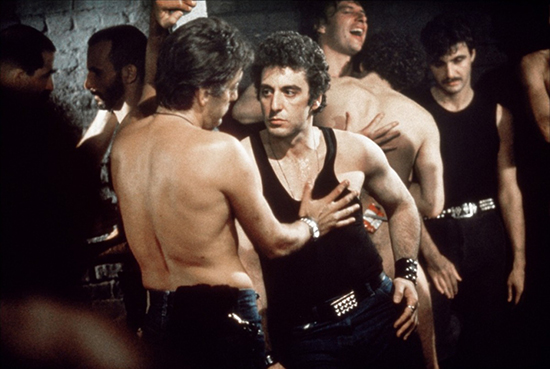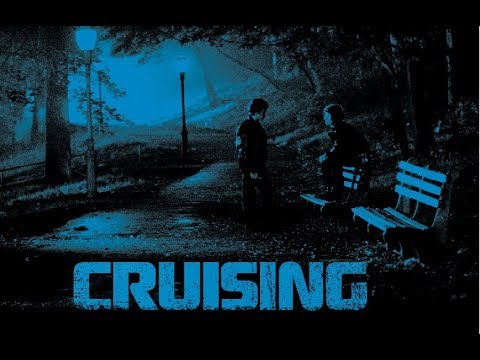There’s one particular scene which springs to mind when I think of William Friedkin’s Cruising. It has nothing to do with scandalous, psychosexual murder; there’s a whole lot of blood rising, but it’s not being spilled. The sense evoked isn’t one of excruciation, but of ecstasy.
The image is de-saturated and dark, but holds an eerily romantic sheen; almost as if the underground leather bar in which we find ourselves, in the company of Al Pacino’s detective Steve Burns, is lit by haze-cutting moonlight. Whistles blow; feet stomp; a sea of husky, scantily- clad men whoop, holler, and clutch at one another like there will never be the chance to do any of these things ever again. Willy DeVille’s “Heat of the Moment,” with its tempting bassline and punky percussion, fills the air.
An attractive man, almost a direct copy of Burns (as is well documented, we gay men apparently like fucking ourselves) drags him on to the dancefloor. Burns is unsteady, unwieldy, anxious; the man hands him a rag, doused in amyl nitrate (“poppers”; a euphoric drug popular on the gay clubbing scene). Burns brings it to his face, and… fireworks.
Friedkin’s direction shines: Cruising’s colour grade pops from a swathe of sickly grey-blue to euphoric vibrancy; the film cuts away, for milliseconds at a time, to a mid-close on a throbbing, backlit star-spangled banner; to other attractive avatars, who gaze upon Burns seductively; and back on Burns dancing, a blurred, slow-motion vision of hedonism.
It’s one of the most authentic depictions of what is a very uniquely queer brand of pleasure: to heartily snort poppers in a packed-out club, surrounded by attractive men, and lose oneself to the airy ripples of a bassline.
The authenticity, of course, breeds some surprise. Friedkin is, as far as we know, a straight man; while he definitely visited New York City’s Fire Island Pines—a hedonistic gay sexual playground—to ‘research’ 1970’s The Boys in the Band, he claims to have turned on his heels and ran upon being propositioned by another man.
And Cruising is not really about the leather scene, or sadomasochism, as much as it’s about a serial killer praying upon gay men in spaces occupied by leather fans and sadomasochists. It’s truly a sign of the times (and, arguably, the cultural veracity that the vast majority of queer films lack) that such an accurate screen depiction of this scene can be found within what is, ostensibly, a schlocky slasher – if a good one.
It was for a combination of both burying the gays and (supposedly) aligning the fringe S&M scene with traditional homosexuality—at a time when gay people sought tolerance from the heteronormative hegemony, obviously an arduous task—that the film received huge backlash from gay rights activists.
It would be disingenuous not to acknowledge the inherent voyeurism of Friedkin’s lens. This film was obviously not made for queer audiences (is any?), but for the mainstream, effectively synonymous with “heterosexual”. Friedkin’s motivation in making Cruising was not to philanthropically emancipate immoral fags and sadomasochists. If you really need evidence for this, just look at his disgust towards queer sex when researching Boys, and his blasé disregard for said gay rights activists.
It’s important to acknowledge that Friedkin’s stylistic approach to the bar scenes of Cruising—with a largely de-saturated colour grade; an abundance of noise-like grain; and cutaway shots of fisting, clearly intended to shock heterosexual audiences, said shock exploited to expand the coffers of United Artists, Friedkin, and Jerry Weintraub—evokes, to some extent, the iconography of a horror movie.
No, William Friedkin did not make Cruising whilst shouting “gay rights”.
But Cruising, a film so often accused by Friedkin’s contemporaries of being an exploitative, inauthentic portrayal of the gay (under)world, now feels rather the opposite—an authentic, incisive, and curious look at a fringe queer milieu oft rejected and now long forgotten. Take the previously described scene: In what might read as a claustrophobic hellscape for mainstream audiences, a queer person might find emancipation.
What especially pervades Cruising, particularly viewed through the contextual prism of modern queer history—that being the kaleidoscopic past 40 years of loss, oppression, political triumph, social anguish—is a sense of historical encapsulation. Away from the scenes of murder, which are no doubt junky, this film captures a very significant, and now lost, historical moment: It echoes from the earliest quakes of gay liberation, and was released just shy of 17 months prior to the now infamous July 3rd, 1981 article in The New York Times: “Rare cancer seen in 41 homosexuals.”
Perhaps the contemporary reaction to Cruising can be read as akin to the re-appropriation of the word “queer” itself. These images, devised for a heterosexual, hegemonic viewership, are seen entirely differently through contemporary queer eyes. And in a post-AIDS world, its scenes of mass male-on-male decadence evoke a sense of the spiritual: Not to put so blunt a phrase on it, but the majority of the men we see in Cruising’s bars would likely die within the next decade, victims of a very heterosexual genocide of neglect.
These are blurred, melancholic memories locked forever within Cruising’s celluloid; a phantasmagoria of men whose liberation was not legislatively delivered, but recovered in the privacy of leather bars and cruising joints. The film overt sexuality makes it hard to escape a sense of catastrophic loss.
I disagree with the slightly antiquated notion that Cruising is, in a wider sense, homophobic. Even a conventional psychoanalytical reading of the film, suggesting that homicide is spurred by heterosexual fears of queer temptation and desire—see: the killer’s propensity to seductive-cum-sadistically tie up his victims; Burns’ only screen-confirmed kill, of his twinky, innocent playwright neighbour, at the film’s denouement, a rejection of the queerness by which he has been tempted—defies the implication that Cruising explicitly denounces homosexuality, as much as it points towards gay panic.
It does however, at numerous points, explicitly scour upon the aggressively masculine, very heterosexual violence—both sexual and not so, although the innuendo always remains—of the NYPD.
Within the first ten minutes of the film, a feminine street hustler is sexually assaulted by a police officer in the front of his car: “I wanna show you my night stick,” the officer quips, in one of Cruising’s many pornographic lines of dialogue. Detectives beat and (as implied, off-screen) rape an innocent murder suspect in an attempt to draw out a confession; one of the film’s most infamous (and protested) scenes sees a muscular black detective, wearing nothing but a cowboy hat and a jockstrap, backhand him across the face.
When Burns shows discomfort with continuing after the beating— “I didn’t come on this job just to shitcan some guy because he’s gay,” he tells his Captain—the violence is brashly justified as “the job”.
It serves to suggest, then, that Cruising’s queer, hedonistic world of sex and leather is hardly hellish, nor is it the source of the film’s danger. It’s incidental to homicide; and while gay sex in graphic and Friedkin’s motivations are incredibly suspect, the film relies on spectatorship for the sex-shocks to deliver. His direction shouldn’t be retroactively vindicated—partially because, while the film is a fascinating watch and sticks as a guilty pleasure, it’s quite the schlocky mess—but what can’t be denied is that these scenes can be witnessed through an entirely different lens for a queer audience.
The overt male-on-male sexuality; the huffing of amyl nitrate rags; the ecstatic, out-of-body sense of losing oneself in the middle of a musky dance floor—all of these images lend to an imagined ideal of an emancipatory queer utopia.



